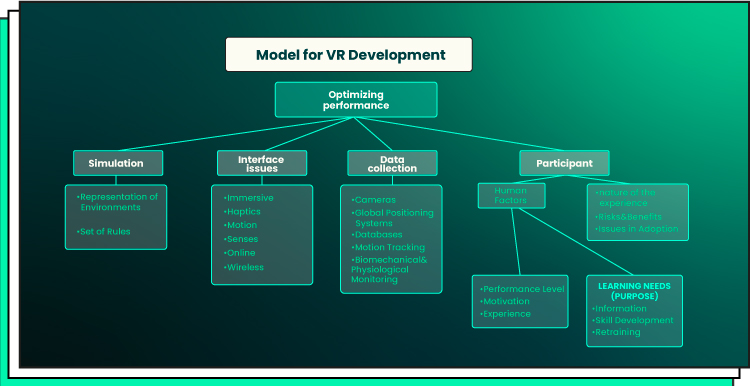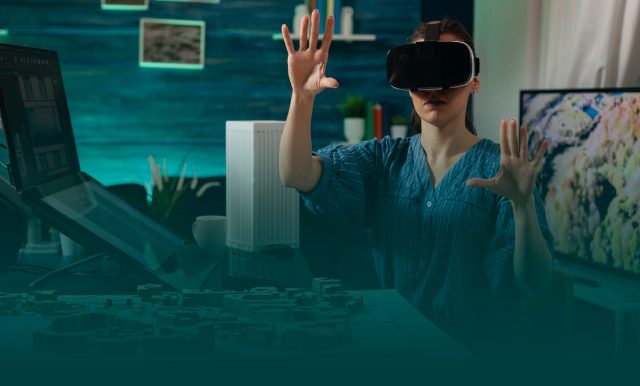As we move into the 21st century, VR development is becoming increasingly essential to businesses seeking to stay ahead of the curve in terms of their technological offerings. By immersing customers in a virtual world and offering them an entirely new level of engagement, VR development solutions enable companies to create lasting impressions on their audiences.
In this blog post, we’ll explore how founders can develop innovative and comprehensive VR applications for their businesses and unlock exciting new arenas of opportunity.
Introduction to VR Development
VR programming is a unique field of software engineering focused on creating immersive user experiences. The development process encompasses a range of tasks, from developing VR tools and applications to designing 3D and virtual environments for educational or entertainment purposes.

The history of VR development is quite extensive. It can be traced back to the 1950s when Morton Heilig developed the Sensorama. This device featured 3D images displayed on a screen and interacted with by viewers. As technology improved throughout the 1960s, researchers began further experimenting with enhancing people’s experiences of virtual worlds.
One of the first successful attempts at creating a VR experience was Ivan Sutherland’s “Ultimate Display” from 1965, which used a unique method of displaying 3D images on a 2D television screen and reactive sensors to track the user’s movements. During this period, other inventors, such as Myron Krueger, began exploring ways of using computer technology to create immersive virtual worlds.
By the 1990s, virtual reality had developed significantly, and gaming companies began incorporating VR into their products. This brought about the popularity of arcade games such as The Lawnmower Man and Virtual Racing, allowing players to experience simulation-based gameplay more realistically than ever before. With the advent of home computing in the mid-1990s, commercial game titles with built-in VR capabilities started appearing on consoles like Sega’s Genesis system. In 1995, Nintendo released Virtual Boy, their own attempt at delivering an immersive 3D gaming experience for home users.
Today, virtual reality technology has advanced significantly from its original form in the 1950s. Developers can now provide a highly realistic sense of depth and immersion thanks to advances in optical tracking systems, motion sensors, and sophisticated computer programming techniques.
Companies like HTC and Oculus have been leading this charge as they produce some of the most innovative devices available for consumers. These gadgets feature complex displays capable of replicating real-world environments with stunning accuracy. This has allowed users to explore digital spaces through interactive gameplay or simply enjoy 360-degree movies without ever having to leave their homes.
VR Technologies Overview
VR technologies are diverse and varied, ranging from hardware such as headsets, gloves, controllers, and bodysuits to software like engines and platforms for creating immersive experiences. VR hardware typically comprises components like headset displays, external tracking systems, audio output devices, controllers (joysticks or handheld remotes), haptic feedback peripherals (vibrating gloves or bodysuits), and motion trackers. These pieces need to work together to provide a truly immersive experience.
Headset displays are the most crucial part of any VR system since they allow users to see virtual worlds in 3D. They come in various shapes and sizes with features such as adjustable focus lenses and integrated speakers or headphones. Some popular headset models include Oculus Rift S, HTC Vive Cosmos Elite, Valve Index, Samsung Odyssey+, and Microsoft HoloLens 2. Tracking systems are also essential – they allow users to move around virtual spaces like they were there. As for controllers or input devices, these range from gamepads to hand-held remotes or even full-body vibrating suits for more intense experiences.
When it comes to software that powers the whole experience, many engines are designed specifically for VR development. Popular options include Unity 3D Engine, created by Unity Technologies in 2005. In addition, Fortnite, the VR game based on another popular VR engine Unreal, is currently the most popular game in the world.

Unity is one of the most popular game engines today, allowing developers to create stunning visuals, realistic physics, and complex artificial intelligence using its robust feature set.
Unity supports several platforms, including Windows, MacOS, iOS, Android, Xbox One, PlayStation 4, and Nintendo Switch. The engine also has an extensive library of asset packs that developers can use to quickly create their projects without starting from scratch.
Unreal Engine offers similar features to Unity but with even more power and flexibility for creating more detailed worlds. It’s especially popular for developing high-end AAA games due to its advanced graphical capabilities.
Other widespread VR engines include:
- CryEngine by Crytek;
- Source 2 by Valve Corporation;
- WebVR by Google;
- Amazon’s Lumberyard;
- ORBX Studio by Japan’s Nippon Ichi Software;
- Marmalade SDK by Marmalade Technologies Limited;
- Torque3D by Garagegames LLC.
The list can be expanded by other engines like Leadwerks Game Engine or Xenko Engine. These engines provide developers with all the tools they need to create realistic environments complete with physics simulations and advanced AI models, among other features.
Finally, when it comes to platforms where users can access these virtual experiences, some big names that immediately come to mind are:
- Oculus Rift owned by Facebook, which was one of the first major companies to enter this space;
- HTC Vive was created by HTC Corporation;
- PlayStation VR launched by Sony Interactive Entertainment in 2016, which was the first console-based Virtual Reality system on the market;
- Microsoft Mixed Reality was developed jointly by Microsoft Corporation and its partners;
- Google Daydream was created as an extension of Android OS back in 2016;
- Apple ARKit was developed exclusively for iOS devices like the iPhone XS Max & iPad Pro 11” 2018 series;
- Samsung Gear VR powered by Oculus Mobile SDK;
- Zeiss VR One powered by TrinusVR engine.
VR Development Tools and Frameworks
The range of tools and frameworks for VR development projects is growing exponentially. Game engines such as Unity and Unreal Engine allow developers to create immersive experiences that can be played on various platforms. These engines offer powerful features such as 3D modeling, animation, physics simulations, shader creation, and more. Additionally, they are designed to be easily integrated with other development tools, such as Adobe Photoshop and Autodesk Maya.
VR development frameworks like A-Frame and Three.js allow developers to build out VR experiences from scratch without needing an expensive game engine license or knowledge of complex coding languages. Instead, these frameworks provide easy-to-use APIs and libraries that make it possible to quickly construct 3D environments in the browser. They also offer access to advanced features such as virtual reality cameras, sound spatialization, physics simulations, and more.
Furthermore, these frameworks are compatible with most major hardware solutions, including Oculus Rift, HTC Vive, Microsoft HoloLens, and Google Cardboard.
In addition to these two main categories of tools used for VR development projects, several other solutions can be employed when creating immersive experiences. For example, platforms like WebVR provide high-quality 3D content within the web browser, while libraries such as React VR focus on improving performance by streamlining the process of creating React applications within VR environments. Also, various plugins are available for popular game engines, enabling developers to quickly integrate their projects with existing hardware solutions like Oculus Go or Samsung Gear VR headsets.
Best Practices for VR Development
When it comes to developing VR experiences, several key components must be taken into account to create an immersive and successful experience.
- VR design. When designing a VR experience, it’s best to think from a user’s perspective. This means considering factors such as how the scene is laid out and how the user will interact with objects in the environment. Ensure each element is well-placed and has a purpose within the environment so that users can easily interact with it. Additionally, consider incorporating spatial sound into your design for an added level of realism and immersion.
- Performance. One way to achieve optimized performance is by ensuring all assets are correctly compressed before loading them into your VR environment. Furthermore, pay attention to frame rate; ensure your environment runs smoothly without hiccups or lag. This can disrupt the user’s experience and make them feel disoriented or nauseous.
- UX. User testing ensures your VR application is up to par before the launch day. Reach out to target users who would likely use your application and allow them to try it out. Ask for their feedback on things like usability and immersion levels within the app. Adjust accordingly based on their input. Conduct multiple tests with various users over time to gain insight into how improvements can be made so that you can create a genuinely exceptional VR experience overall.
Future of VR Development
As hardware becomes increasingly powerful and affordable, more people will have access to high-quality VR experiences. This could lead to more specialized devices designed specifically for different types of immersive content, such as gaming, educational applications, or even medical training simulations. Furthermore, more sophisticated software development tools will make it easier for developers to create complex and engaging VR experiences without completely rebuilding them from scratch each time.
The future of VR development is looking brighter than ever, with some emerging technologies and trends that will make this technology even more immersive and engaging for users. Haptic feedback, eye-tracking, and mixed reality are just a few of the exciting advancements on the horizon.
Haptic Feedback
Haptic feedback technology utilizes devices that vibrate or provide electronic stimulation to give users physical sensations in response to their interactions with virtual objects. This can range from subtle vibrations that mimic the feeling of touching an object to more powerful sensations meant to simulate the effects of extreme temperatures or force. With haptic feedback, VR experiences become even more realistic, allowing users to “feel” their environment instead of merely seeing it visually.
Eye-Tracking
Eye-tracking is also set to revolutionize VR design by allowing developers to track where players focus their gaze throughout the experience. By understanding what players are looking at, developers can create more dynamic content tailored to individual participants’ interests and preferences. Eye-tracking also opens up new possibilities regarding how developers can measure user engagement within an experience, allowing them to optimize the overall quality further.
Mixed Reality
Mixed reality is another critical area of development set to shape the future of VR. In mixed reality (MR) applications, virtual objects appear as if they’re present in one’s physical environment and can be interacted with accordingly. This means users will be able to view and explore 3D environments from multiple angles and interact with them naturally as if they were present. With this new level of immersion, here come countless opportunities for exciting gameplay mechanics and engaging educational applications, making MR a significant factor in the evolution of VR design.

Other trends that may shape the future of VR include:
- Using gesture controllers and voice commands for input instead of controllers or keyboards;
- Adding social features like shared avatars or multiplayer capabilities;
- Creating deeper levels of immersion through sensory stimulators such as wind fans or scent emitters.
Developers are also beginning to experiment with AI-driven NPCs that respond naturally to player actions within a game or simulation world. These combined technologies could lead to more realistic and interactive virtual worlds than ever before. Finally, one emerging trend, in particular, has huge potential for the future of VR: cloud computing solutions like Amazon Sumerian. It allows developers easy access to large amounts of computing power via web services instead of relying on local hardware resources only. This solution could reduce latency issues when streaming data between players and servers while increasing scalability so that developers can create large-scale online games or simulations with ease and cost efficiency.
Final Word
As technology evolves and becomes more accessible, the way we interact with them and explore our environment changes drastically. Ultimately, VR has the potential to revolutionize how we communicate, travel, learn, and play. It’s a cutting-edge evolution that will change how we experience the world around us for years to come.
As developers continue to innovate and find a way to make this technology accessible for all types of users, one thing can be said: the future of virtual reality technology looks bright indeed.
Let’s create more exciting technologies together. We help companies across the globe bring their innovative ideas into reality. Contact Forbytes today if you wish to improve your business strategy and develop high-tech solutions.

Our Engineers
Can Help
Are you ready to discover all benefits of running a business in the digital era?

Our Engineers
Can Help
Are you ready to discover all benefits of running a business in the digital era?







